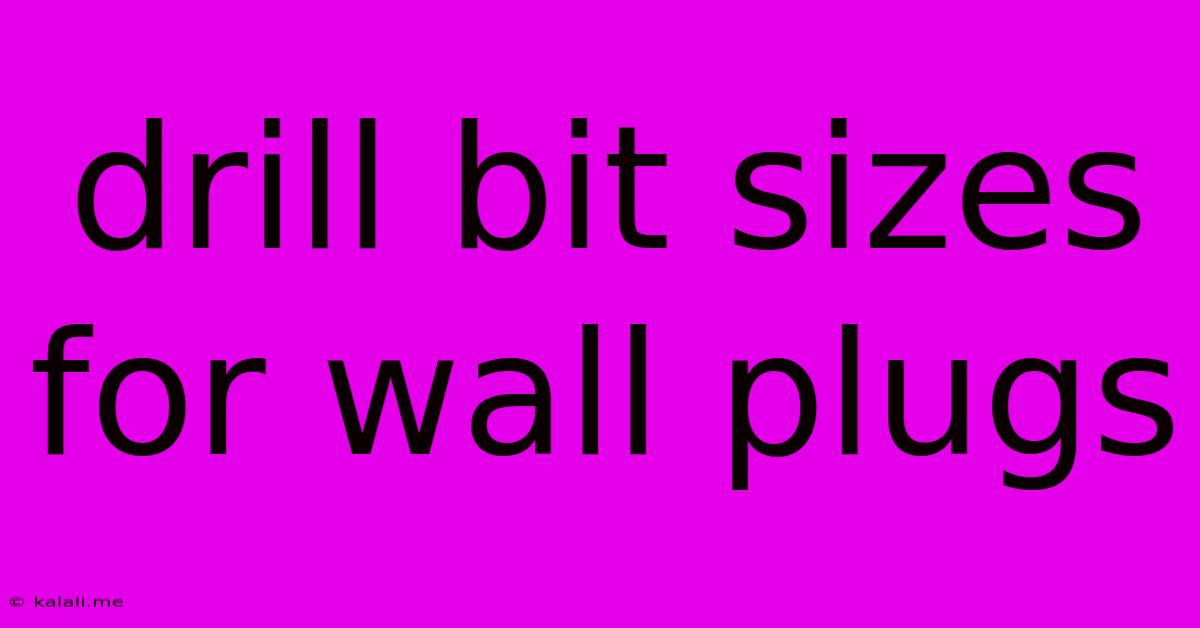Drill Bit Sizes For Wall Plugs
Kalali
May 21, 2025 · 3 min read

Table of Contents
Drill Bit Sizes for Wall Plugs: A Comprehensive Guide
Choosing the right drill bit size for your wall plugs is crucial for a secure and lasting fix. Using the wrong size can lead to loose fittings, damaged walls, and ultimately, a frustrating DIY experience. This comprehensive guide will help you navigate the world of drill bit sizes and wall plugs, ensuring your next project is a success. This article covers common plug types, matching drill bits, and helpful tips for achieving the perfect fit.
Understanding Wall Plugs and Their Applications
Wall plugs, also known as anchors or rawlplugs, are essential components for securely mounting items to walls. They create a stable base within the wall cavity, preventing screws from pulling straight through weaker materials like plasterboard or drywall. Different plug types are designed for different wall materials and load-bearing requirements. Common types include:
- Plastic Wall Plugs: These are versatile and suitable for lightweight items in plasterboard or solid walls. Sizes vary considerably.
- Nylon Wall Plugs: Known for their strength and durability, these are ideal for heavier items in various wall materials.
- Metal Wall Plugs (e.g., Molly Bolts): These heavy-duty plugs are necessary for exceptionally heavy items or where exceptional holding power is required in softer materials. They are expanded once inserted and offer a very secure fixing.
- Toggle Bolts: These are designed for hollow walls and offer superior holding power compared to standard plugs.
Matching Drill Bit Size to Wall Plug Size
The most important factor to consider is the diameter of the wall plug. The drill bit should be slightly smaller than the plug's diameter to ensure a snug fit. A too-large hole will result in a loose plug and a poor fixing. A too-small hole will make inserting the plug difficult, possibly damaging both the plug and the wall.
Here’s a general guideline: The drill bit diameter should be approximately 1-2mm smaller than the wall plug's diameter.
For example:
- 6mm Wall Plug: Use a 4-5mm drill bit.
- 8mm Wall Plug: Use a 6-7mm drill bit.
- 10mm Wall Plug: Use an 8-9mm drill bit.
Always refer to the manufacturer's instructions on your specific wall plug packaging. This is the most reliable way to determine the correct drill bit size for optimal performance. The packaging will often explicitly state the recommended drill bit size.
Choosing the Right Drill Bit Material
The material of your drill bit is equally important. For plasterboard, a standard high-speed steel (HSS) bit will suffice. For harder materials like brick or concrete, consider using a masonry bit, which is specifically designed for tougher applications. These are typically made from carbide or titanium-coated HSS.
Tips for Success
- Pre-drill pilot holes: Pre-drilling a pilot hole, especially in harder materials, helps prevent cracking and chipping of the wall.
- Use the right drill: Using a cordless drill allows for more control, especially when working with softer materials.
- Don't force it: If you encounter resistance while inserting the wall plug, stop and check your work. You may need to use a slightly smaller drill bit or use a different type of wall plug.
- Clean the hole: Removing dust from the hole before inserting the plug will ensure a secure fit.
By following these guidelines and paying close attention to the manufacturer's instructions, you'll be well-equipped to choose the correct drill bit size for your wall plugs and achieve a perfect installation every time. This will guarantee the stability and longevity of your fixings. Remember safety first! Always wear appropriate safety glasses when drilling.
Latest Posts
Latest Posts
-
What Is The Plural Of Business
May 21, 2025
-
What Is The Difference Between Pasta And Noodles
May 21, 2025
-
Can You Drink The Tap Water In Spain
May 21, 2025
-
How Long Do Half Elves Live
May 21, 2025
-
How Can I Find Out If Someone Is Married Uk
May 21, 2025
Related Post
Thank you for visiting our website which covers about Drill Bit Sizes For Wall Plugs . We hope the information provided has been useful to you. Feel free to contact us if you have any questions or need further assistance. See you next time and don't miss to bookmark.